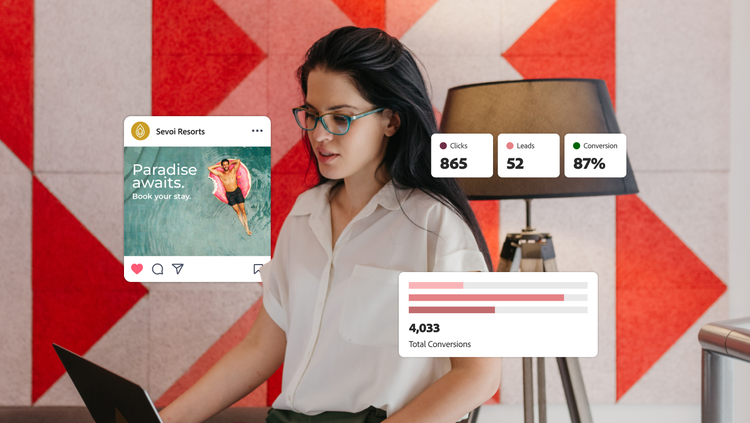For ecommerce retailers, conversions are everything. Marketing and advertising drive traffic and build brand awareness, but once visitors land on your website, your job isn’t done — it’s just beginning.
That’s where ecommerce conversion rate optimization (CRO) comes into play. CRO helps businesses refine their websites, purchasing workflows, and user experiences to turn more visitors into paying customers. By improving these critical areas, you can maximize ROI, improve customer satisfaction, and scale your ecommerce operations.
In this guide:
- What is ecommerce conversion rate optimization?
- Ecommerce conversion rate goals
- Ecommerce conversion rate optimization strategies
- Common mistakes with CRO
- Create your own CRO strategy
What is ecommerce conversion rate optimization?
Ecommerce conversion rate optimization (CRO) is the practice of increasing the percentage of website visitors who take desired actions — like making a purchase or signing up for a newsletter — through strategic improvements to website design, usability, and workflows.
For example:
- Simplifying checkout workflows: Reducing the number of steps required to complete a purchase.
- Building trust: Adding security badges like “Secure Checkout” on payment pages.
Why is conversion rate important?
- Revenue impact: A 1% increase in conversion rate on a $10 million site adds $100,000 in revenue instantly.
- Marketing efficiency: Helps businesses get more out of existing traffic, reducing dependence on new lead acquisition.
- Customer journey optimization: Ensures a smoother experience, moving users quickly through the funnel from awareness to purchase.
How to calculate conversion rate.

The formula for conversion rate is straightforward:
(Conversions ÷ Visitors) x 100 = Conversion Rate
For example, if your site had 2,000 visitors in a day and 20 made a purchase:
(20 ÷ 2,000) x 100 = 1% conversion rate
Ecommerce conversion rate goals.
What’s a good conversion rate?
Conversion rate expectations vary by industry, audience, and product type:
- Ecommerce average: 3.3%.
- New stores: Expect 1–2% initially as you establish your digital presence.
- Service-based ecommerce: Often closer to 9%, due to simpler purchasing workflows.
Setting benchmarks for your business.
Rather than solely comparing to averages, consider:
- Your target market: Conversion rates for high-cost luxury goods often differ from fast-moving consumer goods.
- Purchase complexity: Products requiring detailed research (such as electronics) may see lower conversion rates than simpler items (such as fashion).
- Historical performance: Use your baseline data to track improvements over time.
Measuring success.
To measure CRO success, track key performance indicators (KPIs), such as:
- Cart abandonment rate: Understand where users drop off in the funnel.
- Lead-to-customer ratio: Identify conversion efficiency.
- Average order value (AOV): Gauge if higher conversions drive larger purchases.
Ecommerce conversion rate optimization strategies.
If your conversion rate is underperforming, start by auditing your site and workflows. Here are proven strategies to boost conversions:
1. Create eye-catching pages.
-
Simplify the user experience: Present key information upfront and design pages to be intuitive and easy to navigate.
-
Use high-quality content: Invest in professional visuals and videos to showcase your products clearly.
-
Optimize product pages: Add detailed descriptions, testimonials, reviews, and videos to highlight benefits and build trust.
-
Include social proof:
- Add dynamic elements like “X people are viewing this now” or “500+ purchases this month” to build urgency and credibility.
- Highlight the number of reviews and average ratings for each product directly on the product pages.
-
Use CTAs sparingly: Overloading users with pop-ups and CTAs can overwhelm them. Stick to clear, consistent messaging.
2. Offer incentives.
Encourage action by offering time-sensitive perks, such as:
- Free shipping thresholds.
- Discount codes or free products for first-time buyers.
- Loyalty programs with rewards for repeat purchases.
3. Make your store easy to navigate.
- Streamline navigation bars: Organize categories intuitively with minimal nesting.
- Implement filters: Let users sort by size, color, or other criteria to find products faster.
- Enhance search functionality: Use auto-complete and intelligent keyword matching to improve search accuracy.
4. Simplify the purchasing process.

- Guest checkout: Reduce friction by letting users buy without creating an account.
- Optimize checkout forms: Prefill data where possible, minimize required fields, and use dropdowns to simplify entries.
- Easy returns: Display customer-friendly return policies to reassure hesitant buyers.
5. Optimize website performance.
- Improve load times: Aim for under two seconds to prevent user drop-offs.
- Mobile optimization: Ensure responsive designs with intuitive mobile navigation.
- Use a content delivery network (CDN): Boost speed by delivering content from servers closest to users.
- Improve Core Web Vitals: Optimize metrics like Cumulative Layout Shift (CLS) and Time to Interactive (TTI) for better user experience.
6. Build trust.
- Showcase reviews and testimonials: Customers trust peer feedback. Highlight reviews prominently on product pages.
- Be transparent: Make contact information, policies, and pricing clear and accessible.
- Display security badges: Reassure users about payment safety with trust symbols like SSL certificates and third-party logos.
7. Test and iterate.
- A/B testing: Experiment with different headlines, CTAs, layouts, or offers to identify what drives the most conversions.
- Monitor heatmaps: Understand user behavior to identify bottlenecks or high-engagement areas.
- Use analytics: Track performance metrics like bounce rates, cart abandonment, and conversion rates to refine strategies.
Common CRO mistakes.
Neglecting mobile optimization.
Mobile ecommerce accounts for a significant portion of online sales, yet many websites fail to offer seamless mobile experiences.
-
The problem: A site that isn’t mobile-friendly causes friction, leading to high bounce rates and lost conversions.
-
How to fix it:
- Test your site using tools like Google’s Mobile-Friendly Test to identify usability issues.
- Optimize navigation for smaller screens, ensuring buttons and CTAs are easy to tap.
- Use responsive designs that adapt seamlessly across viewports.
Ignoring page speed.
Page speed is critical for user experience and conversion rates. Slow-loading pages frustrate users, causing them to abandon the site.
-
The problem: Users expect pages to load in under two seconds, yet many ecommerce sites exceed this threshold, especially on mobile.
-
How to fix it:
- Test your site using tools like Bing’s Mobile Friendliness Test Tool to identify usability issues.
- Optimize navigation for smaller screens, ensuring buttons and CTAs are easy to tap.
- Use responsive designs that adapt seamlessly across devices.
- Use Google Chrome’s Lighthouse Tool to audit your mobile performance and identify areas for improvement.
- Go beyond lab data by analyzing real user metrics like First Input Delay (FID) and Largest Contentful Paint (LCP) in tools like Google Search Console or Core Web Vitals reports for actionable insights into live user behavior.
Overcomplicating the user journey.
A cluttered, confusing, or overly lengthy purchasing process can drive users away, even if they’re interested in your products.
-
The problem: Too many steps, unclear navigation, or excessive form fields create friction that discourages users from completing purchases.
-
How to fix it:
- Simplify checkout workflows by minimizing the number of required steps.
- Offer guest checkout to reduce friction for first-time customers.
- Use clear, logical navigation structures with intuitive categories and filters.
- Ensure CTAs guide users naturally through the purchasing process.
Create your own CRO strategy.
Steps to build a CRO strategy
- Audit your website: Use tools like Google Analytics or heatmaps to identify high-exit pages.
- Set SMART goals: Define specific, measurable, achievable, relevant, and time-bound targets for CRO.
- Test continuously: Incorporate A/B testing and iterate based on user feedback.
- Monitor KPIs: Track metrics like bounce rates, cart abandonment, and customer lifetime value.
With Adobe Commerce, you can take these steps to the next level:
- Personalize product pages to engage users and build trust.
- Streamline checkout with secure, flexible payment options.
- Use integrated analytics to refine strategies in real time.
Request a product demo to find out how Adobe Commerce can help ensure you’re efficiently converting customers.


